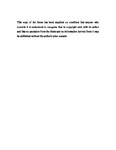Service Quality Improvement Through Lean Management at King Khalid International Airport in Saudi Arabia
| dc.contributor.supervisor | Graham-Jones, Jasper | |
| dc.contributor.author | Almuharib, Tariq Mohammed | |
| dc.contributor.other | Faculty of Science and Engineering | en_US |
| dc.date.accessioned | 2014-10-15T13:52:47Z | |
| dc.date.available | 2014-10-15T13:52:47Z | |
| dc.date.issued | 2014 | |
| dc.identifier | 10373820 | en_US |
| dc.identifier.uri | http://hdl.handle.net/10026.1/3137 | |
| dc.description | Full version unavailable due to 3rd party copyright restrictions | |
| dc.description.abstract |
This thesis aims at investigating the level of service at departure area of KKIA. The study further measures the perceived quality of service and passenger satisfaction in term of tangibles, reliability, responsiveness, assurance and empathy by using five steps of lean six sigma (Define, Measure, Analyse, Improve and Control). The study aims to implement and evaluate the effectiveness of using a lean six-sigma managerial approach to the departure area of KKIA to enhance the level of service (LOS) and customer satisfaction. The passenger flow through the airport is used to measure the quality of services. Existing studies that discuss lean six-sigma implementation in airports were evaluated. Data was collected about KKIA departure area and its LOS both before and after the lean six-sigma implementation. Additionally, a SERVQUAL questionnaire was used to evaluate pre- and post-implementation review. The questionnaire features easy-to-collect data to measuring the perceived quality of service and evaluate passenger satisfaction with the LOS in KKIA. Before the study concepts of LOS and Lean was unheard within the airport community. Initial evaluation show poor customer service and many delays (waste) within the departure are at KKIA. During the study a growing awareness of Lean and LOS showed improvements in the customers’ experience, e.g, removing the shop at the entrance, improving flow thought the airport. Concluding the study, there was a total reduction in waiting from 54.74 minutes to 34.87 minutes (35.7% reduction). Also the LOS on the IATA Performance Standard went from E (Inadequate) to C (Good). This is improvement, excellent but without continuous improvements the Airport’s LOS will reduce back as passenger numbers grow from 16 million passengers per year (up from 9.8 million in 2004), to an expected 25 million by 2025. Interesting different cultural approaches to lean management became evident during the study when compared to other implementations in Europe to the Middle East. Cultural difference will always affected the reliability of the results. However, by considering these cultural effects in answering questions and interviews, the lean implementation was still successful. As culture changes are ongoing, evaluation of the situation at KKIA is required for ongoing improvements. Best-practice for the continued improvement of ongoing lean management is suggested for the departure area at KKIA. These key strategies and best-practice approaches are useful to future implementations at other airports. | en_US |
| dc.description.sponsorship | Saudi Arabia government scholarship | en_US |
| dc.language.iso | en | en_US |
| dc.publisher | Plymouth University | en_US |
| dc.subject | Lean thinking | en_US |
| dc.subject | Service quality | en_US |
| dc.subject | Six Sigma | en_US |
| dc.subject | Lean Six Sigma | en_US |
| dc.subject | KKIA | en_US |
| dc.subject | Change Management | en_US |
| dc.subject | Saudi Arabia culture | en_US |
| dc.subject | SERVQUAL | en_US |
| dc.subject | Level of Service | en_US |
| dc.title | Service Quality Improvement Through Lean Management at King Khalid International Airport in Saudi Arabia | en_US |
| dc.type | Thesis | |
| plymouth.version | Full version | en_US |
| dc.identifier.doi | http://dx.doi.org/10.24382/4744 |
Files in this item
This item appears in the following Collection(s)
-
01 Research Theses Main Collection
Research Theses Main


